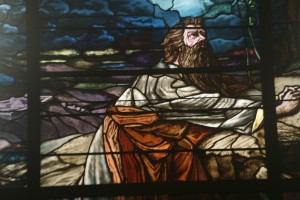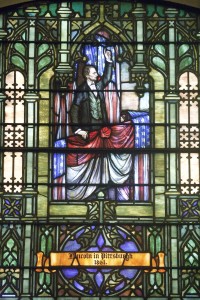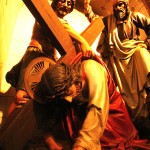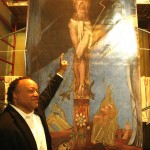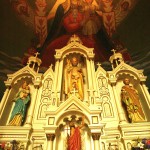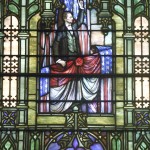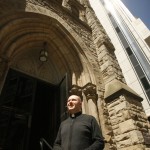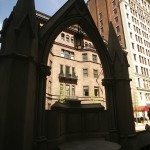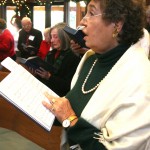A Pilgrimage of Faith
Story & photos by Dave Bartruff“I was glad when they said unto me, let us go into the house of the LORD!” Psalm 122:1
It was pitch-dark and raining hard as my flight from California touched down on the runway at the once-legendary “Steel City” of Pittsburgh, Pennsylvania.
Inside the terminal it was after hours and dark and void of activity with closed shops and airline counters.
Outside at the curb however, there was a single cab whose driver who would miraculously turn the dreary nighttime arrival into a blessed welcome for me!
“Odi” was my cabby’s name.
Born in Jerusalem, the son of a Jewish father and Roman Catholic mother 46 years ago, Odi was also a man of the world having resided in Europe and now for the past 14 years in Pittsburgh.
On assignment myself to explore Pittsburgh’s deep spiritual roots of faith, Odi, was a Biblical scholar and a true Godsend for the half-hour drive to my hotel located in the heart of Pittsburgh’s ethnic “Deutschtown” German neighborhood.
Built in 1888 as a Benedictine monastery, today The Priory is Pittsburgh’s only European-style boutique hotel with 42 handsome guest rooms. Adjoining it across a delightful courtyard is the former St. Mary’s Church. Today it now serves as the hotel’s Grand Banquet Hall with its walls and ceiling a stunning display of stained glass.
Pittsburgh, itself, is located along a “Golden Triangle” where the Alleghany and Monongahela Rivers merge to form the serene Ohio River. The city’s development is a true “American Success Story,” and one of faith as well.
Founded by the British in 1758, the small town was visited even earlier in 1753 by a 21-year-old major in the fledgling Continental Army by the name of George Washington! And in time Pittsburgh grew from a wilderness outpost into “America’s Gateway to the West.”
Later the city would develop into America’s industrial giant driven by the names of Carnegie, Heinz and Westinghouse.
But now it is a new day and the start in my quest for the city’s rich religious heritage. Surprisingly, the pilgrimage begins out of doors in the Biblical Botanical Garden of the Jewish Temple Rodef Shalom. The temple itself dates to 1855.
I was greeted by Dr. Walter Jacob the retired Rabbi Emeritus of the temple he served since 1966. Dr. Jacob described how he and his wife, Irene, established its unique Biblical garden on the park-like grounds of the synagogue in 1986. All of the garden’s plantings, trees and flowers are indigenous to the Holy Land, the only such garden found outside Israel.
Later we entered the gorgeous temple itself. Opened in 1907, its sanctuary accommodates 1,200 worshipers. Just two years later, by invitation, Wm. Howard Taft became the first sitting U.S. President to address a Jewish congregation in its sanctuary during Sabbath services.
Across town and over one of Pittsburgh’s many bridges, it is a climb to Troy Hill overlooking the Allegheny River on the city’s North Side. My destination is the world-renowned Roman Catholic St. Anthony’s Chapel, proudly designated a Pittsburgh Historical landmark.
On display within the church is its fabled collection of more than 5,000 holy relics, second in number only to the Vatican in Rome.
Also adorning both sides of the sanctuary is an exquisite collection of life-size wooden carvings representing the 12 Stations of the Cross crafted by renowned German artisans centuries ago.
Next, into the heart of downtown Pittsburgh itself, I find it is possible to go on foot to visit an entire collection of historic churches located just a few blocks apart.
Certainly they paint a true picture of a city built on faith.
My first discovery begins beneath the splendid 170-foot spire atop the First Lutheran Church dating to 1888. Within its sanctuary is also one of Pittsburgh’s earliest stained glass masterpieces, an exquisite “Good Shepherd” window covering over 500 square feet of opalescent glass by Tiffany designer Frederick Wilson.
Just a few blocks away I enter Smithfield United Church. Its unique aluminum spire is illuminated throughout the night.
The church, designed for its German Evangelical Protestant congregation, was acquired and built on land donated by the heirs of William Penn in 1787.
Smithfield is also the oldest organized church in the city. Its gorgeous Rose Window at the front of the sanctuary is a breathtaking 19 feet in diameter. Other outstanding windows depict the three Biblical aspects of Faith, Hope and Love in the narthex.
Twelve tall double windows enlighten the house of worship itself, six on either side occupying over 60 per cent of the sanctuary’s walls.
- Choir leader in church sanctuary
- Famous “12 Stations of the Cross”of St. Anthony’s Chapel
- Famed murals of Maxo Vanka
- Chancel of St. Nicholas Croatian Catholic Church
- Spring blossoms in courtyard, Priory Hotel
- Lincoln stained glass window, Smithfield United Church of Christ
- Pastor, 1st Lutheran Church downtown Pittsburgh
- Church Deacon opens huge interior sanctuary door downtown Presbyterian Church
- Pastor prays over sanctuary offering
- Youth prayer time with pastor
- Elevated outdoor pulpit First Presbyterian Church downtown Pittsburgh
- Moses at prayer window: Jewish Rodef Shalom Temple
- Hymn sing from pews
The upper portion of each window illustrates the life and teachings of Jesus; the lower portion, the people and places of the church’s German Protestant heritage such as Martin Luther at Wittenberg during the 16th Century Reformation and Abraham Lincoln at Pittsburgh in 1861.
Nearby, Trinity Cathedral dating to 1872, retains much of its Mid-Victorian character. In honor of Pittsburgh’s 250th anniversary in 2008, 130 years of soot and grime were removed from its sandstone exterior as well as the restoration of its burial ground that contains some of the oldest graves in the city.
Near neighbor to Trinity is the First Presbyterian Church also erected on former William Penn property.
Its breathtaking sanctuary has a narthex nearly the length of a football field. Separating it from the congregation’s pews are two great doors of solid oak and each 30 feet high, and weighing two tons a piece.
Perfectly balanced and operating on a track in the floor, a church deacon shows me how he can easily open and close each of the giant doors with just a single finger!
Flags of many nations decorate the sanctuary to represent the mission work that the church supports in the city of Pittsburgh, the United States and worldwide.
Fourteen beautiful stain-glass windows grace the length of each wall of the sanctuary. Thirteen were designed and installed by Tiffany and the 14th, the product of Charles and Frederick Lamb.
A large five-panel stained glass window at the end of the chapel known as the “Stem of Jesse” designed in England, trace the lineage of Jesus back to the father of King David and also portray highlights of Christ’s ministry on earth.
But now, my pilgrimage to Pittsburgh’s pillars of faith is about to end. Only one final landmark remains.
Just beyond the city limits lies the tiny hilly hamlet of Millvale overlooking the waters of the Alleghany. It became home to a Croatian population from Europe who immigrated to the United States in the late 1800s and early 1900s.
In all, some 50,000 Croatians arrived with many of the men finding work in Pittsburgh’s bourgeoning steel mills.
Devoid at first of the new language and culture, the newcomers found their comfort and hope in their families and church life in the sanctuary of St. Nicholas Croatian Catholic Church, built and dedicated in 1900.
Over the years, however, damaged by fire and in debt, the sanctuary needed a lift. It finally came about in 1937 when its dynamic new pastor Father Albert Zagar commissioned an unknown but talented Croatian artist Maxo Vanka to decorate the walls and ceiling of the sanctuary with murals.
The talented Vanka completed eleven mammoth ceiling murals within eight weeks in 1937 and returned in 1941 to paint more. Finally, in 1950 he added artistic Croatian folk designs to the walls of the choir loft.
Docent-led tours of the Vanka Murals are given each Saturday at 11 am and 12 noon and 1 pm.
Visit: docentmanager@vankamurals.org www.vankamurals.org Also contact: Pittsburgh History & Landmarks Foundation www.phlf.org The Pittsburgh Visitors Bureau: VisitPITTSBURGH.com http://saintanthonyschapel.org/ http://thepriory.com/ http://rodefshalom.org/
